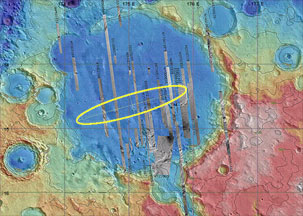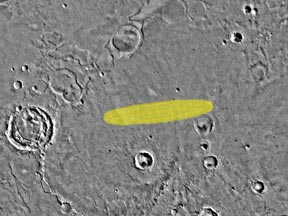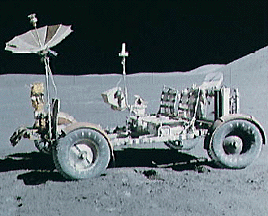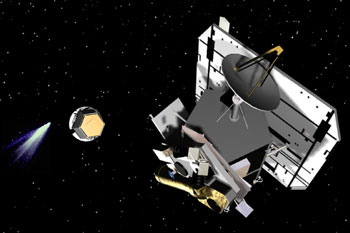A rocket carrying Spirit blasts off from Florida on June 10, 2003.
Click on image for full size
Image courtesy NASA.
What will happen when on the MER missions?
Both Mars
Exploration Rovers (MER) were launched
from Florida in the summer of 2003. The first, Spirit, blasted off on June 10.
The second, Opportunity, blasted off on July 7. Each spacecraft spent about
six months in space on the way to Mars.
Spirit and Opportunity made it safely to Mars in January 2004. Spirit landed
in Gusev
Crater on January 3, 2004. Opportunity landed on Meridiani
Planum on January 24, 2004.
The spacecraft were going very fast, about 19,000 km per hour (12,000 mph),
when they got to Mars! They slowed down very quickly when they went into the
atmosphere of Mars. Their heat shields kept them from burning up. They had parachutes
that slowed them down some more. They also had airbags around them to make their
landings softer. They bounced more than 20 times when they landed!
After they stopped bouncing they let the air out of their airbags. Then they
unfolded themselves. Each rover
spread out its solar panels and unfolded its wheels. Engineers on Earth tested
each rover to make sure they were OK. Then the rovers drove onto the surface
of Mars. We think the rovers can last about 90 days on Mars. They are exploring
during the daytime and "resting" at night. After a while the solar
panels will stop making enough electricity to keep the rovers going. We hope
to learn a lot from them before that happens!
You might also be interested in:

Two robot rovers landed on Mars in January 2004. The first robot is named Spirit. Spirit landed inside a big crater called Gusev Crater. Gusev Crater may have been filled with water long ago. It may have
...more
Two robot rovers landed on Mars in January 2004. They are called the Mars Exploration Rover mission. One rover is named Spirit. The other is called Opportunity. Opportunity landed at a place called Meridiani
...more
The Hubble Space Telescope (HST) is really neat! It was first launched in 1990, but scientists started building it in the 1970's! We have found all kinds of objects like stars, nebulae and galaxies. The
...more
Apollo 11 was the first mission that landed a person on the moon. On July 16, 1969, the U. S. rocket Saturn 5 was launched carrying the lunar landing module Eagle. The Eagle was released and it reached
...more
Apollo 12 was launched on Nov. 14, 1969 and arrived at the Moon three days later. Astronauts Charles Conrad and Alan Bean descended to its surface, while Richard Gordon remained in lunar orbit aboard the
...more
Apollo 15 marked the start of a new series of missions from the Apollo space program, each capable of exploring more lunar terrain than ever before. Launched on July 26, 1971, Apollo 15 reached the Moon
...more
NASA chose Deep Impact to be part of a special series called the Discovery Program. This program is for cheap, scientific projects. In May 2001, NASA said it was ok to start with mission development for
...more















